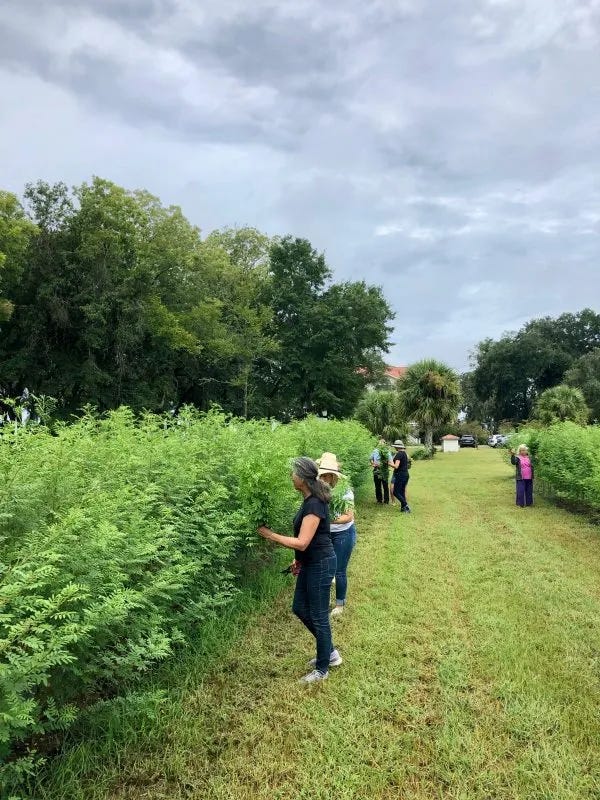The Blue that Captivated the World
Indigo- a long obscured piece of history is being revived.
Edisto Island is a flat sub-tropical barrier island just south of Charleston - a place of majestic live oaks, heavily laden with Spanish moss that forms cathedral-like canopies over ever-winding sandy roads. Black gum trees, live oaks, and scrub brush line the sides of Hwy. 174 as it winds its way toward the sea. Oysters crowd the creek banks and shrimp, blue crab, and mullet are there for the taking for anyone with a cast net. Most of the land is a jungle of tangled oaks, magnolia trees, palmettos, and yuccas standing high above a woodland floor.
Once this land was a refuge for escaped slaves who armed themselves, joined Confederate forces, and clashed with Union soldiers during the Civil War. Union forces later positioned themselves on Edisto where they developed a staging area for future campaigns against Charleston, just twenty-five miles away. Eventually, the colony of African Americans grew and the Union Army protected thousands of freed slaves who had taken refuge on this barrier island deep in the heart of the Lowcountry.
This historic island is the location for the farm where Caroline (pronounced care-oh-lean) and her husband David Harper are growing indigo. Upon meeting them I immediately was interested because of their unbridled passion for the deep meaning behind the product, the historical significance to our state of South Carolina. Here is a bit about why this story matters.
The Quick Rise and Fall of Indigo
Indigo was the most profitable cash crop in Colonial America. Its roots run deep into the history of South Carolina. It all started with Eliza Lucas Pinckney, one of the most influential agriculturalists in the South. In the mid 1700s, while managing her father’s Charleston-area plantation on Wappoo Creek, Pinckney laid the foundation to develop indigo.
For 50 years, starting in the late 1740’s, indigo was a major South Carolina cash crop, second only to rice. The labor-intensive process of growing and processing indigo relied heavily on enslaved Africans. Thousands - perhaps tens of thousands- of slaves were needed. For this reason, the cultural memory of indgo is heightened among members of the African-American community along what is now called the Gulllah Geechee Cultural Heritage Corridor in SC, Georgia and Florida.
The entire purpose of the Carolina colony was to produce resources and wealth that would enhance the British economy and support the expansion of the British empire.
At one time, the extracted pigment, dried and shaped into circular cakes, was so prized that it was sometimes called blue gold, and used as currency - even as barter for slaves.
After the Revolutionary War, indigo processing fell into obscurity. It permanently dismantled the traditional mercantile links between American farmers and British customers.
Indigo is a beautiful substance that is inexorably linked to a long and painful chapter in the history of SC. By acknowledging the full breadth of its local history, we remember the enslaved people with blue-stained hands whose lives and labors contributed to the successs of the South. Indigo truly is part of the fabric of South Carolina history.
The Revival of Indigo Today
This historic connection inspires Caroline Harper and her husband David, and today they are at the forefront of reviving indigo through their company, CHI Design Indigo. “There is magic in this plant that reconnects us to the land and each other,” says David. “Educating people about the plant’s connection to the past is the cornerstone of our business. We host events and workshops aimed at educating people about the rich history surrounding indigo and teach them how to plant, grow, harvest, and process it,” explained David.
The Harpers are not alone in their enthusiasm for indigo. David is on the board of the Charleston-based International Center for Indigo Culture, a non-profit whose mission is to inspire and create a new farm-to-fabric economy and culture based on the indigo plant and its dye. They provide education in indigo's history, science, and art to people of all ages and represent a growing network of farmers, natural dyers, and textile artists passionate about creating a new indigo culture.




Thank you for your feedback. I love hearing from readers and getting comments. It's one of the best things about this journey.
This is fascinating, Pat. Thank you for sharing! Katie